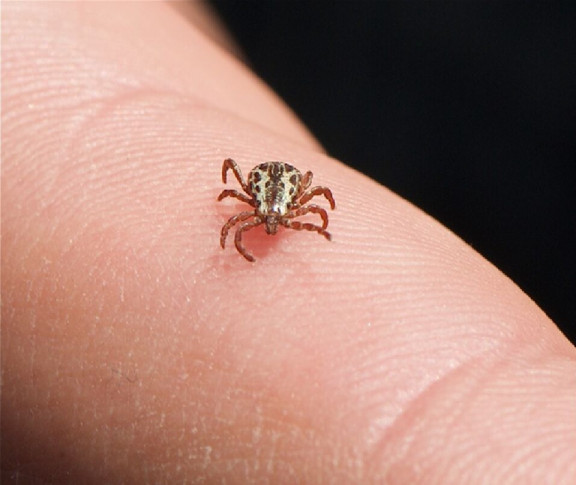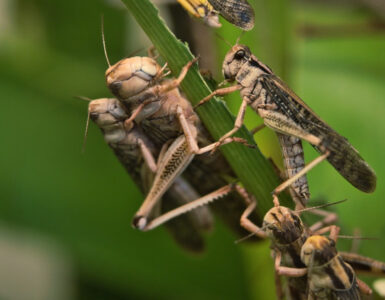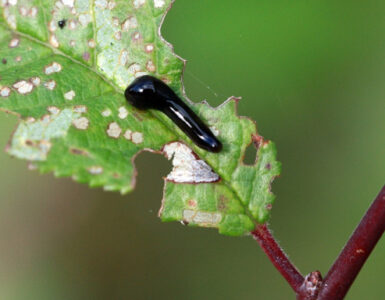Ticks are more than a nuisance. They can pose serious health risks to you, your family, and your pets.
If you’re dealing with ticks in your home or yard, here’s a comprehensive guide on natural ways to get rid of them.
Identification
Ticks are small, oval-shaped parasites that can be difficult to spot. Depending on their age and whether they have been fed recently, they range in size from a poppy seed to an apple seed [1].
Their color varies from reddish-brown to dark brown or black. Adult ticks have eight legs, making them arachnids, and their bodies can swell significantly after feeding.
These pests are known carriers of various diseases, including Lyme disease and Rocky Mountain Spotted Fever [2]. If left untreated, these illnesses can have severe, long-lasting effects.
Adult ticks attach to their hosts’ skin and feed on blood, sometimes for days, increasing the risk of disease transmission.
How to Get Rid of Ticks in the House and Yard Naturally
You can use the home remedies and natural solutions below to help reduce and remove ticks from your home and yard. This helps keep your family and pets safe.
1. Maintain a Tidy Yard
Leaf litter and other yard debris provide ideal hiding places for ticks.
To keep ticks away, regularly remove leaves, grass clippings, and other organic matter from your yard. This action makes it harder for them to nest near your home.
2. Salt
Salt is a natural desiccant that dries out and kills by dehydrating. It works well for killing tick eggs and larvae.
Therefore, sprinkle salt on carpets, rugs, and other areas where ticks might hide. Leave it overnight, then vacuum it up thoroughly.
3. Boric Acid
Boric acid is another natural tick killer. It dehydrates and ultimately kills the larvae and eggs that come into contact with it.
Therefore, boric acid powder should be applied to carpets, rugs, and other target areas. Let it sit for a few hours before vacuuming.
4. Lemon Oil
Ticks also hate the smell of lemon oil. Therefore, you can mix lemon oil with water and spray it around your home.
You can also use it directly on your skin to help keep ticks at bay. Add 12 drops of lemon oil to one ounce of witch hazel. Shake well and apply to your body, focusing on exposed areas.
5. Cedar Oil
Cedar oil is a natural repellent for tick nymphs [3]. It can be used both indoors and outdoors.
Mix 20 drops of cedar oil in a cup of water. Spray it on carpets and areas where ticks are likely to be, such as your backyard, around dog and cat bedding or resting areas, and rugs.
You can also use it to mist your clothes, curtains, and other fabrics.
6. Oregano Oil
This oil also works great for killing and deterring ticks. It can kill ticks that come into contact with it.
You can also use oregano oil to make a DIY tick repellent for your skin. Just add 10 drops of oregano oil to two tablespoons of carrier oil, shake well, and apply to your skin to help keep ticks away.
7. Practice Good Pet Hygiene
Cats, dogs, and other pets can bring ticks into your home, so it is essential to treat them regularly with tick-prevention products.
You can use natural options like essential oil sprays, or periodically check their bodies for ticks and remove them.
To make an essential oil spray for ticks on dogs, add 10 drops of your chosen oil to 1 cup of apple cider vinegar. Shake well, then mist your dog’s fur.
8. Mow the Lawn and Keep It Hydrated
Some ticks will hide in tall grass, so keep your lawn mowed short. Some tick species also prefer dry areas, so a well-hydrated lawn is less likely to harbor them.
9. Discourage Unwanted Animals from Entering Your Property
Ticks often enter your yard from wildlife such as deer, rodents, horses, cattle, and stray animals.
If possible, discourage these animals from entering your property, or keep them as far away from your house as possible.
10. Rubbing Alcohol
Dropping ticks in rubbing alcohol is also an effective way to kill them on contact.
If you find a tick on yourself or your pet, use a pair of tweezers to remove it, then drop it into rubbing alcohol. It will kill the tick immediately.
11. Diatomaceous Earth
Food-grade diatomaceous earth is deadly to ticks but safe for humans and pets.
You can spread it in areas where ticks are likely to be found. This includes the perimeter of your yard, gardens, and cracks and crevices in your home.
This product works by dehydrating and killing these pests upon contact.
12. Wash Bedding and Clothes in Hot Water
Ticks can latch onto bedding, clothing, and other fabrics.
Wash these items in hot water to kill any ticks that may be hiding in them. The intense heat will instantly kill these parasitic feeders and their eggs.
13. Neem Oil
Neem oil is a natural pesticide that can also kill ticks.
You can mix two teaspoons with your pet’s shampoo. Massage the shampoo into the pet’s coat, then rinse it out.
14. Declutter and Clean the House Thoroughly
A cluttered house provides plenty of hiding spots for ticks.
Therefore, regularly declutter and deep clean your home. This will help get rid of spots where ticks might hide.
Pay special attention to areas where pets spend a lot of time.
15. Vacuum Regularly
Regular vacuuming is one of the best ways to remove ticks from your home.
Focus on areas like carpets, rugs, furniture, and pet bedding. Be sure to empty the vacuum bag or canister immediately after vacuuming to prevent ticks from escaping.
16. Apple Cider Vinegar
Apple cider vinegar is often used as a natural tick and flea repellent.
Mix equal parts apple cider vinegar and water to create a spray. Then, apply it to your pet’s coat.
In addition, add a teaspoon of apple cider vinegar to your dog’s water bowl.
17. Natural Predators
Certain animals and insects prey on ticks, helping to keep their population in check.
Encourage natural predators, like birds, frogs, and dragonflies, to live in your yard.
Also, invite opossums, ladybugs, and spiders. These animals can help control the tick population by feeding on them.
You can attract these predators by creating a welcoming environment with water sources, shelter, and food.
18. Seal Gaps Between Windows and Doors
Ticks can enter your home through tiny gaps in windows, doors, and walls. Therefore, seal these gaps to prevent ticks from getting inside.
19. Repellent Plants
Several plants are known to repel ticks. Consider incorporating these into your yard or using them in homemade sprays.
Rosemary, lavender, marigold, and mint are great tick-repellent plants. Planting these around your yard can naturally deter ticks.
Moreover, some chrysanthemums have pyrethrum. This natural insecticide repels ticks and other pests.
20. Eucalyptus Oil
You can also use this essential oil to make a homemade tick-repellent spray for your home.
Mix 20 drops of eucalyptus oil with 4 ounces of water in a spray bottle. Spray this solution around your home.
Focus the spray on areas where ticks are likely to be found, such as doorways, windows, and baseboards. They dislike its scent.
21. NemAttack™ and NemaSeek™ Nematodes
These beneficial nematodes will happily feed on tick larvae and other pests. You can apply them to your yard, where they will seek out and kill ticks in the soil.
22. Dr. Earth Final Stop Pest Control Killer Spray
Dr. Earth’s Final Stop Pest Control Killer Spray is an organic product that quickly kills ticks and other pests. It can be applied indoors or outdoors.
Takeaway
Combining these natural methods can significantly reduce the tick population in your home and yard.
While no solution is entirely foolproof, one or more homemade tick killers or repellents on this list can protect you, your children, and your pets from these pests.








Add comment